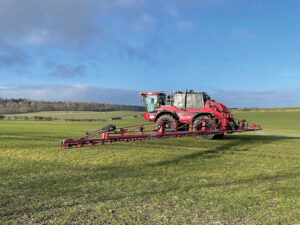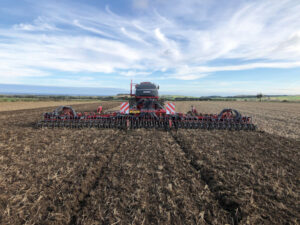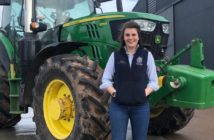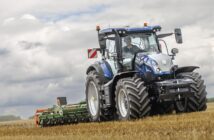A double winner at the National Arable and Grassland Awards, David Fuller manages the substantial McGregor Farms on the Scottish Borders.
Taking the stage for both Oilseed Grower of the Year and the prestigious Grower of the Year event, David Fuller said that the double award win was a testament to the hard work of the team at McGregor Farms. It’s a team that encompasses six full time operators, another six part time and self-employed workers brought in at peak times, and an office and management team of five that oversees the day-to-day organisation and administration.
The 300-hectare base farm is surrounded by a further 3,300 ha, cropped in an eight year rotation. In any given year half will be down as wheat, with potatoes grown on rented ground, other ground set aside for leeks and sprouts, barley and vining peas make up a percentage of the remaining ground, with around 700 hectares put down as oilseed rape.

David Fuller, centre, collects the Grower of the Year award from former NFU president Meurig Raymond, right, and host Justin Moorhouse.
When David joined the business in 2008, having grown up and worked through Lincolnshire and Yorkshire, he came with a plan to retain an attention to detail across a large scale and use best practise to improve yields consistently and sustainably.
This has been implemented through a combination of targeted investments and BASIS and FACTS training across the management team. McGregor Farms has adopted various precision farming systems, including variable seed and fertiliser, and lime spread in target areas.
“We’ve had the soils conductivity mapped, which has given us a head start in regards to caring for the ground,” he said. “We have fairly acidic soils here, so those variable applications of lime help us to combat this.”
On the precision farming side, the company recently went through a significant change, moving fleet from Trimble over to John Deere. The impetus for this was John Deere’s Greenstar and MyJohnDeere systems, enabling the wireless transfer of field and task data across the fleet.
“It certainly came at a cost,” David explained. “But the benefits have outweighed this. Life is simpler now, being able to instantly send information to the operators, and they can send data straight back. Not only that but we get excellent back up from our local dealer Thomas Sheriff & Co.”
McGregor Farms runs two 6215Rs and two 6185Rs, with a planned five year replacement policy and a hire-in scheme for haulage tractors during harvest. Three Case Quadtracs provide the high horsepower, purchased nearly new and pulling a trio of 7m Simba SL cultivator, a 10m CultiPress and a 12m Horsch Pronto drill to establish the bulk of the cropping. For smaller, awkward fields or during adverse weather, the farm also utilises a 4m Lemken Solitair.

The Agrifac sprayer is fitted with pulse width modulation, section control and variable rate to adjust input.
“Having that second system available to us takes the pressure off during difficult sowing seasons,” said David. “We can get the crop in with one of the smaller, lighter tractors if ground conditions won’t allow the Quadtracs and the larger kit.”
The farm handles its own spraying with two Agrifac Condor Vs, fitted with section control, variable rate and pulse width modulation. Nitrogen is applied as a liquid fertiliser, to manage fertiliser needs and spread the cost of running a self-propelled sprayer.
For harvesting, the farm runs three Claas Lexions, all mounted on TerraTrac chassis. The two larger 8700 machines are equipped with 12.3m Convio Flex headers, these are backed up with an older 770 machine. Alongside the sprayers, the combines are on a six-year replacement policy.
Continuous benchmarking
When it comes to crop choice, David explains that the farm is constantly benchmarking its performance – having been successful in several Yield Enhancement Network (YEN) awards. He’s also open to trial work, having a relationship with companies such as Bayer, BASF and Corteva to test new varieties and inputs in field conditions.
“It’s easy to get caught up in having the highest yield but these trials mean that I can look at the other unique selling points of the varieties,” he said. “Take oilseed rape, it can be a difficult crop to take to harvest, but taking part in trials gives me a first-hand look at the other traits that can minimise the pressure, whether it’s pod shatter resistance or how susceptible it is to turnip yellows virus, light leaf spot or sclerotinia.”
When asked what the farm does to consistently get high quality, good yielding oilseed rape crops and to be judged Oilseed Grower of the Year, he refers back to that attention to detail.
“80% goes in after wheat and we get straight on the ground to make sure that seedbed is right because the windows here in Scotland are so tight,” David said. “We try and minimise seed numbers and pay close attention to the variety, favouring hybrids because of the bank of traits they have.
“Even then, there’s no silver bullet. You can do everything right and there are still risks. We thought we had a great crop of oilseed rape and escaped the dreaded cabbage stem flea beetle, but during a NIAB survey we found larvae in a significant number of stems. You have to be on the ball or these factors can get the better of you.”

The bulk of the rotation is wheat, with potatoes, barley and break crops making up the balance.
He adds that the farm cannot afford to have a ‘one size fits all’ mentality. There has been a shift away from soil inversion but the plough is still on site as a last resort. David explained that in tricky seasons, the plough has helped with the vining pea crop establishment, as well as facilitating a clean break if weed pressure is particularly high in a field.
Soil health is a key concern for David but the farm remains a business and the tight windows in Scotland mean that cash crops are the priority. “We’re looking at cover crops but we harvest late and, more often than not, need to get the next crop in the ground as quickly as possible. This makes cover crops very difficult to justify. They come at a cost and aren’t in the ground long enough to make a real difference. Saying that, they could be a viable alternative if we’re forced to miss a cash crop.”
Working at capacity
It’s a fine balance between staffing numbers, machinery and weather, along with meeting client expectations, according to David. As a consequence, McGregor Farms is not actively looking for additional ground, with the current landbase, staff and equipment working well together. With the tight weather windows, this means that any expansion would have to be carefully considered.
“You never say never but we’re keen to keep any ground within that 15-mile radius,” he said. “It costs too much to farm the road.”
He added that the company has never chased work, instead the ground and the various agreements with local farmers have come through word of mouth. “The farm was fully kitted out to handle its own potato cropping in the early nineties, which led to them working with neighbouring farms,” he said.
Since then the farm has taken on new ground through referrals and recommendations, ensuring that every block of ground is in the right condition to add viable yields to the business. “It’s about that attention to detail,” David concluded. “From the first time we step into the field, to the moment the harvester leaves.”
More information
Read about the 2023 NAGA winners, including this year’s Grower of the Year Award winner here.
For news and updates about the NAGA awards, nominees and winners, follow
National Arable and Grassland Awards
#NAGAwards




